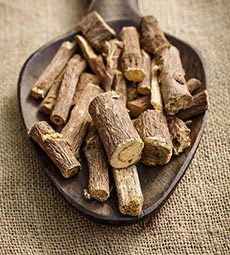What is Licorice?
Licorice gets its name from the Greek glyks, meaning sweet and rhiza meaning root. It is the sweet tasting rhizomes (underground stems) and roots that are used as flavourings. It is native to south-eastern Europe and the Middle East, where it grows wild. It was known to the Greeks, mentioned in the Hippocratic texts, and to the Romans, who made licorice extract as we do today.
Ancient Chinese herbalists used licorice, distilling the root’s essence and prescribing it for a wide range of conditions. Licorice is particularly well known for its use in confectionery. It was cultivated in England since the 16th century by Dominican monks in Pontefract, Yorkshire, where the confectionery trade began.
Spice Description
Licorice is the rhizome of a bean plant, both the vertical main tap root and horizontal subsidiary rhizomes being used. The dried roots look like pieces of dried wood, very hard and fibrous, about I cm (3/8”) in diameter, with brown skin and a yellow interior. It is available as dried, woody pieces of root, as a powder and as solid sticks of concentrated essence which are glossy black, sweet and partly soluble in water.
Bouquet: medicinal and highly aromatic.
Flavour: sweet tasting, similar to anise, with a slightly bitter, slightly salty aftertaste. When chewed on its own it seems to get sweeter and sweeter.
Hotness Scale: 1
Preparation and Storage
The dried root need only be kept dry and will store indefinitely. It can be sliced or ground before using. Powdered licorice should be kept in air-tight containers.
Culinary Uses of Licorice
Licorice is known mostly as a confectionery flavouring, especially Licorice Allsorts or Pontefract cakes. Licorice candy actually rarely has more than 2% natural licorice extract, usually taking most of its flavour from anise or a synthetic substitute. Ninety percent of all natural licorice employed as a flavouring agent is used in tobacco (cigarettes, cigars, pipe tobacco).
The sticks of licorice essence may be dissolved in hot water and drunk as a tisane and the roots may flavour fruit juices, syrups and for flavouring drinks like sambuca and beers like Guinness.
Health Benefits of Licorice
Licorice helps cleanse the colon, supports lung health, and promotes adrenal gland function. Licorice is a common ingredient in throat-soothing herbal supplements. Its natural sweetness makes it a favorite flavor in herbal teas and many food products.
Herbal preparations containing Licorice Root are used to treat stomach and intestinal ulcers, lower acid levels and coat the stomach wall with a protective gel. Rarely used alone, It is a common component of many herbal teas as a mild laxative, a diuretic, and for flatulence. It has also been known to relieve rheumatism and arthritis, regulate low blood sugar, and is effective for Addison’s disease. The Root extract produces mild estrogenic effects, and it has proven useful in treating symptoms of menopause, regulating menstruation, and relieving menstrual cramps.
Licorice, may also be used for night sweats. Heartburn, stomach ulcers or gastritis, are the main symptoms for using licorice, proving particularly beneficial for these ailments when combined with other elements such as balm of caraway, milk thistle, lemon and chamomile.
Licorice is an effective anti-inflammatory, thus decreasing the cough and stimulates the production of chemicals that can treat ulcers.
Licorice has an ancient reputation as an aphrodisiac; the Kama Sutra and Ananga Ranga contain numerous recipes for increasing sexual vigour which include licorice. The herb Licorice root should not be confused with confectionery licorice.
Licorice should not be taken long term or by people with high blood pressure.) Large or frequent doses of licorice can lead to acute hypertension.
Licorice Side Effects
Glycyrrhizin is a component of licorice that is considered harmful to health; it could cause a greater sensitivity on the part of the body to aldosterone (a hormone of the kidney) as well as cause headaches, fatigue, leg swelling, heart attacks and high blood pressure. People suffering from heart, liver, diabetes or hormone-sensitive diseases, should not take licorice.
Plant Description and Cultivation
A tall erect legume, standing up to 1.5 m (5 feet) tall, the plant bears small spikes of lilac-coloured flowers that bear bean-like pods which contain 3 or four seeds. The root descends about 1 m (3 ft) underground, sending out an extensive network of rhizomes, which are grown for three to five years before they are harvested. The roots and rhizomes are cleaned, pulped, then boiled and the licorice is then concentrated by evaporation.
Other Names
Black Sugar, Licorice Root, Liquorice, Sweetroot, Sweetwood
French: regliss
German: Lakritze
Italian: liquirizia
Spanish: regaliz
Indian: mulethi
Scientific Name
Glycyrrhiza glabra Fam Leguminosae

